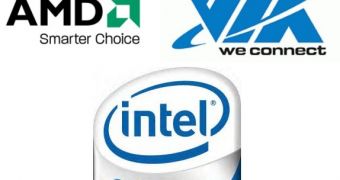Next year is expected to bring some changes on the netbook market, or, at least, this is what VIA and AMD are said to be planning. The latest reports on the Web say that the two are aiming at stealing some market share from Intel's Atom chip. The netbook market is rapidly growing and the Atom has become the chip of choice in the field. It barely faces any competition at the moment, yet things are expected to change before Atom marks the end of its first year of existence.
VIA has its Nano processor that could stand a chance in this segment, as it has managed to score some early wins in the mini-note space, with the Linux-powered Cloudbook (built on VIA’s NanoBook reference design), from the US retailer Everex, and the HP 2133 netbook. Nano went down as soon as Atom surfaced the market, and Intel won ASUS, Acer, Dell, Lenovo, MSI, and Toshiba on its side.
VIA lost HP as partner last month, when the vendor decided to opt for Atom for its new Mini 1000, saying that VIA's C7-M processor had been an option for 2133 at a time when Atom wasn't ready for the designed netbook. The maker also added that 2133 would be refreshed with an Atom platform. VIA is said to come up with a new strategy, aiming more at the emerging markets called BRIC – Brazil, Russia, India and China, which are expected to outpace already established markets, like North America, Europe and the developed regions from Asia.
The emerging markets see rapid growth, mostly owing to low-cost laptops, like the netbooks for instance, and less due to conventional desktop or notebook PCs. VIA considers that it has a great opportunity in this segment, as the netbooks produced under its “cheap-enough and good-enough” model could become a give-away component in deals offered by telcos and wireless broadband players. The Nano processor is considered less powerful than Atom, nonetheless, it is more power-efficient and cheaper to manufacture, which means that the Nano-based netbook will have a lower price.
VIA has the NanoBook architecture, which allows manufacturers to build their own netbooks on a ready-made platform. The company has also announced the Global Mobility Bazaar Program, meant to attract partners into building VIA-based netbooks for BRIC and other price-sensitive markets. According to Epan Wu, VIA’s senior director of CPU Product Marketing, the global market for “affordable mobile computing devices” is expected to reach nearly 30 million units by 2010.
Second-tier Taiwanese and Chinese OEMs are expected to be attracted by VIA, while established leaders like Quanta and Compal, ASUS, Clevo, Wistron and Invertec are less likely to do so. VIA is also aiming at handheld mobile Internet devices, although Intel is already there with its Silverthorne-class Atom chips, while also planning the second-gen Atom “Moorestown” platform for a 2010 debut. The VIA Ultra Mobility Platform is found in Korea’s Wibrain B1 UMPC, running a 1.2 GHz VIA C7-M processor.
AMD, on the other hand, is working on a processor designed specifically for netbooks. The chip hasn't been unveiled yet, but some of its specifications are expected to surface this week. According to the company, the chip will address both video performance and battery life, laying emphasis mainly on the latter. “You would expect 8 or 9 hours out of a netbook... for some of the ones that I’ve tested, probably the hottest one has an 1 hour 45 minutes of battery life. You’re not going to take that with you as a road warrior,” said Pat Moorhead, AMD’s vice-president of Advanced Marketing.
Moorhead has also expressed his concerns about the price netbooks have today. While the first ASUS Eee PC initially came at $499, the average selling fee for the machines is around $699 today, even reaching $1,000 in some particular cases, due to larger screens and storage. “We do have strategies together with our OEMs for pushing our solutions both down into smaller form factors and lower notebook price points” says Dirk Meyer, AMD president and CEO.
AMD is also expected to use its ownership of ATI to leverage the video performance of the planned netbook platform, while also developing the chip under the smaller and more power-efficient 45nm process technology. Intel has been manufacturing its Atom processor under the 45nm fabrication process, while VIA's Nano can be found in both 65nm and 45nm packages.

 14 DAY TRIAL //
14 DAY TRIAL //